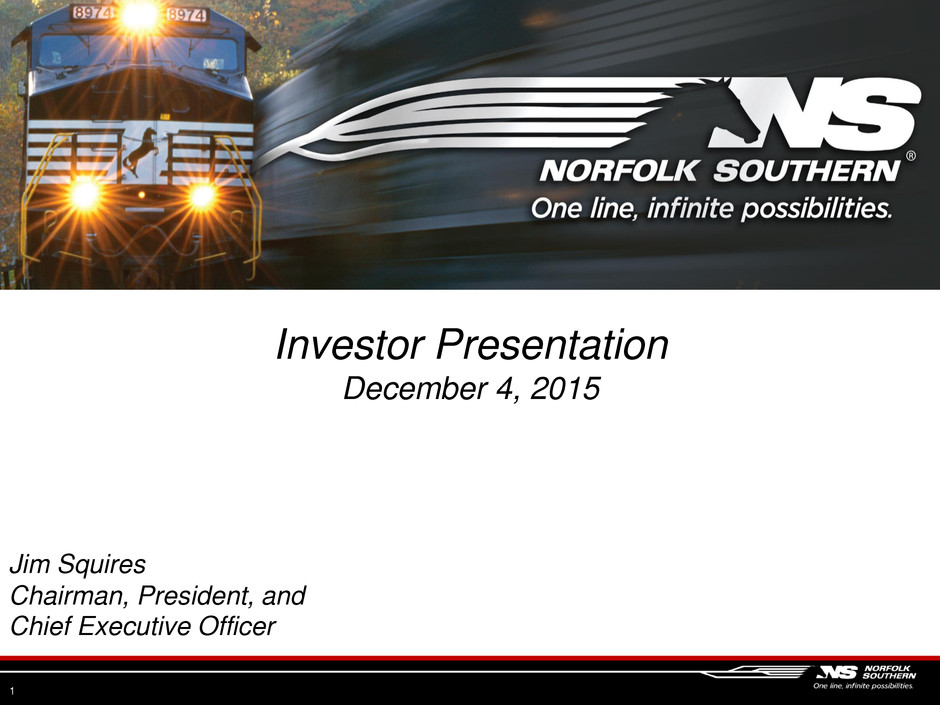
1 Investor Presentation December 4, 2015 Jim Squires Chairman, President, and Chief Executive Officer
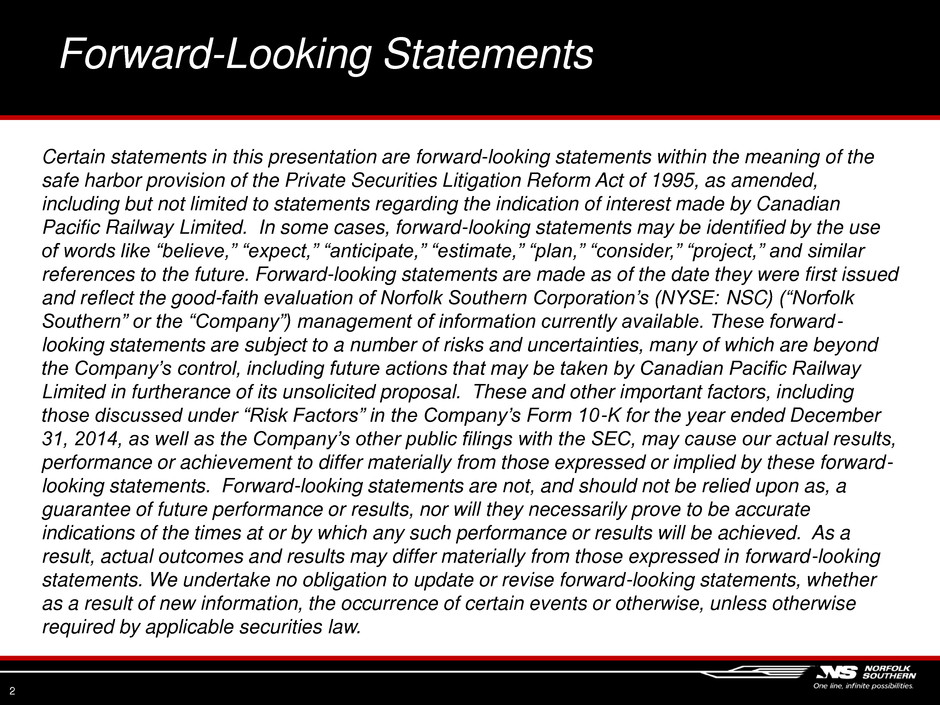
Forward-Looking Statements 2 Certain statements in this presentation are forward-looking statements within the meaning of the safe harbor provision of the Private Securities Litigation Reform Act of 1995, as amended, including but not limited to statements regarding the indication of interest made by Canadian Pacific Railway Limited. In some cases, forward-looking statements may be identified by the use of words like “believe,” “expect,” “anticipate,” “estimate,” “plan,” “consider,” “project,” and similar references to the future. Forward-looking statements are made as of the date they were first issued and reflect the good-faith evaluation of Norfolk Southern Corporation’s (NYSE: NSC) (“Norfolk Southern” or the “Company”) management of information currently available. These forward- looking statements are subject to a number of risks and uncertainties, many of which are beyond the Company’s control, including future actions that may be taken by Canadian Pacific Railway Limited in furtherance of its unsolicited proposal. These and other important factors, including those discussed under “Risk Factors” in the Company’s Form 10-K for the year ended December 31, 2014, as well as the Company’s other public filings with the SEC, may cause our actual results, performance or achievement to differ materially from those expressed or implied by these forward- looking statements. Forward-looking statements are not, and should not be relied upon as, a guarantee of future performance or results, nor will they necessarily prove to be accurate indications of the times at or by which any such performance or results will be achieved. As a result, actual outcomes and results may differ materially from those expressed in forward-looking statements. We undertake no obligation to update or revise forward-looking statements, whether as a result of new information, the occurrence of certain events or otherwise, unless otherwise required by applicable securities law.
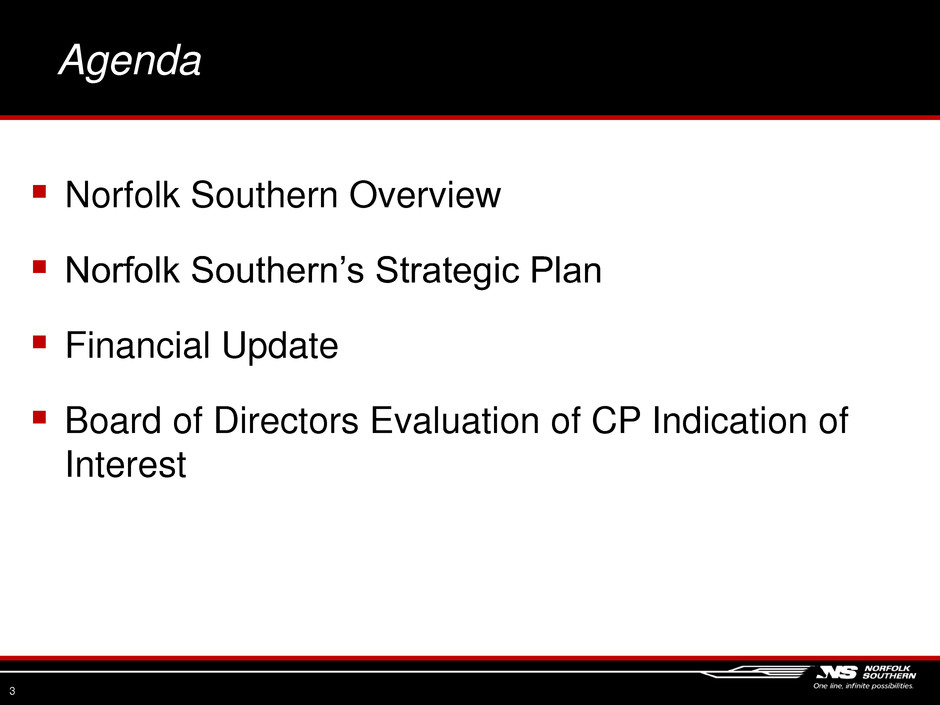
Agenda 3 Norfolk Southern Overview Norfolk Southern’s Strategic Plan Financial Update Board of Directors Evaluation of CP Indication of Interest
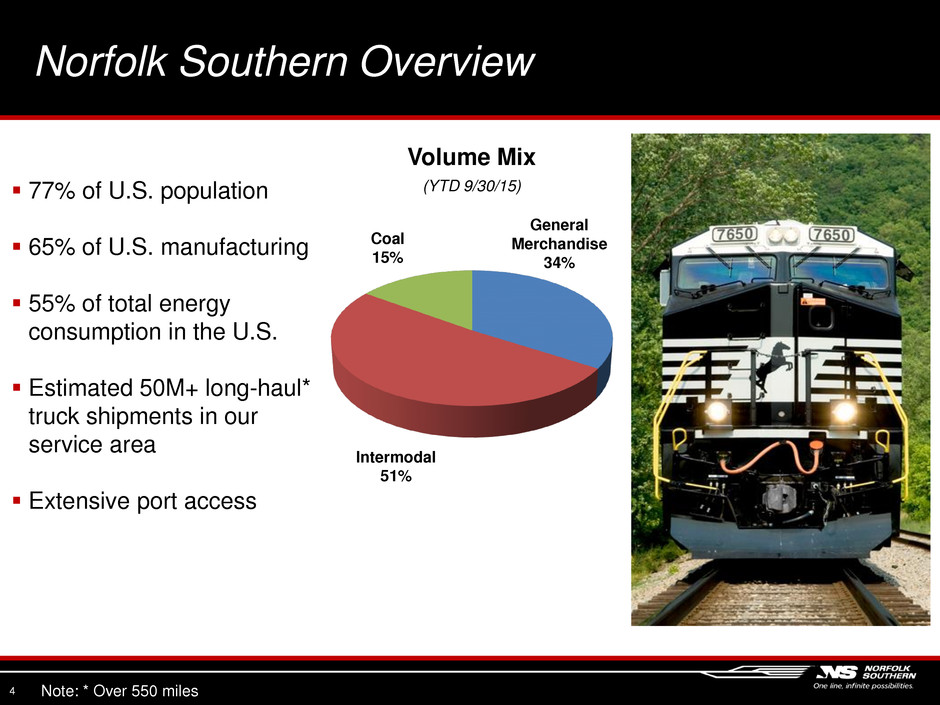
Volume Mix (YTD 9/30/15) 77% of U.S. population 65% of U.S. manufacturing 55% of total energy consumption in the U.S. Estimated 50M+ long-haul* truck shipments in our service area Extensive port access Intermodal 51% Coal 15% General Merchandise 34% 4 Norfolk Southern Overview Note: * Over 550 miles
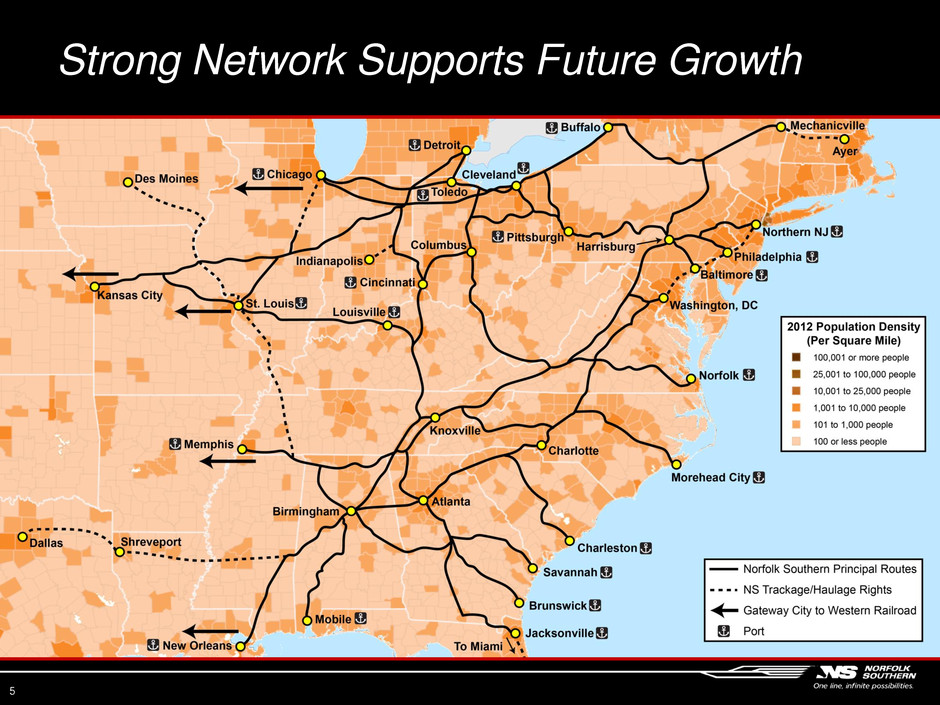
Strong Network Supports Future Growth 5
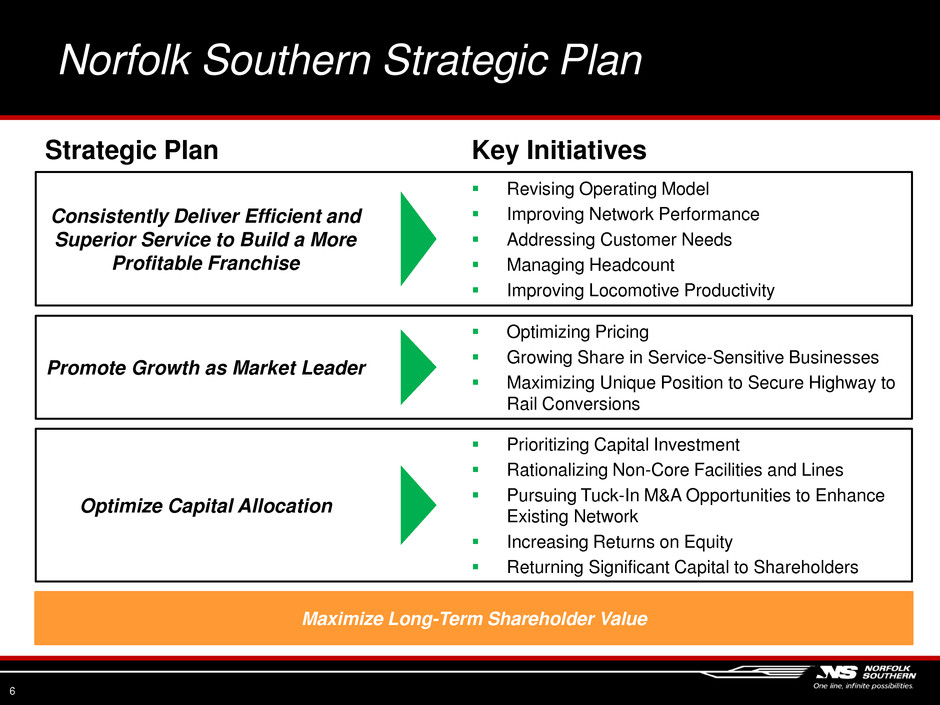
Strategic Plan Consistently Deliver Efficient and Superior Service to Build a More Profitable Franchise Key Initiatives Revising Operating Model Improving Network Performance Addressing Customer Needs Managing Headcount Improving Locomotive Productivity 6 Norfolk Southern Strategic Plan Promote Growth as Market Leader Optimizing Pricing Growing Share in Service-Sensitive Businesses Maximizing Unique Position to Secure Highway to Rail Conversions Optimize Capital Allocation Prioritizing Capital Investment Rationalizing Non-Core Facilities and Lines Pursuing Tuck-In M&A Opportunities to Enhance Existing Network Increasing Returns on Equity Returning Significant Capital to Shareholders Maximize Long-Term Shareholder Value
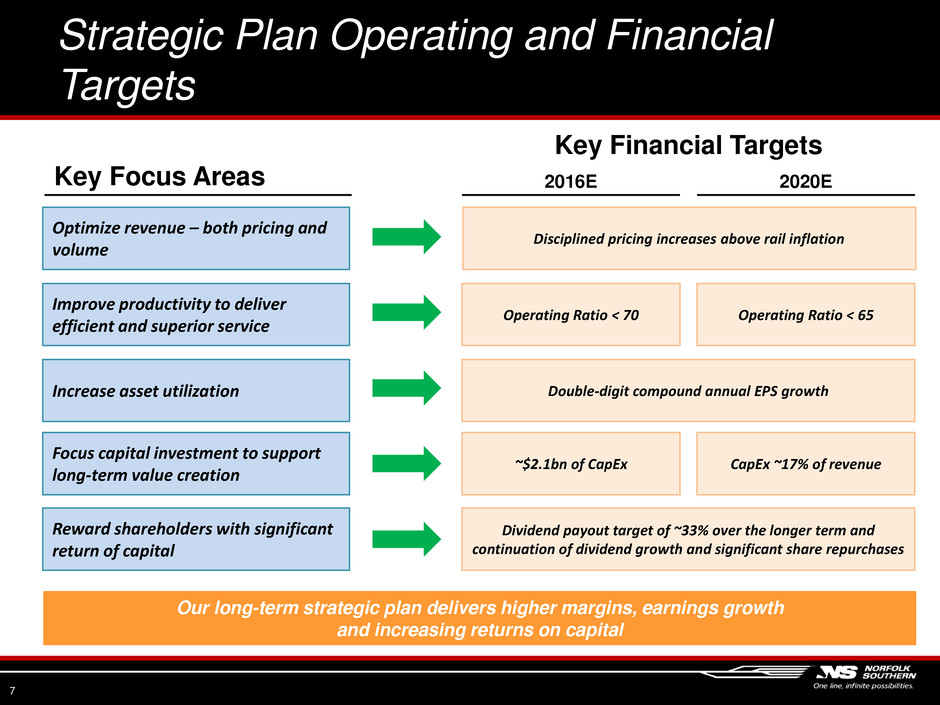
Strategic Plan Operating and Financial Targets 7 Increase asset utilization Optimize revenue – both pricing and volume Double-digit compound annual EPS growth Improve productivity to deliver efficient and superior service Reward shareholders with significant return of capital Operating Ratio < 70 Focus capital investment to support long-term value creation ~$2.1bn of CapEx Key Focus Areas Key Financial Targets Our long-term strategic plan delivers higher margins, earnings growth and increasing returns on capital Operating Ratio < 65 Dividend payout target of ~33% over the longer term and continuation of dividend growth and significant share repurchases CapEx ~17% of revenue 2016E 2020E Disciplined pricing increases above rail inflation
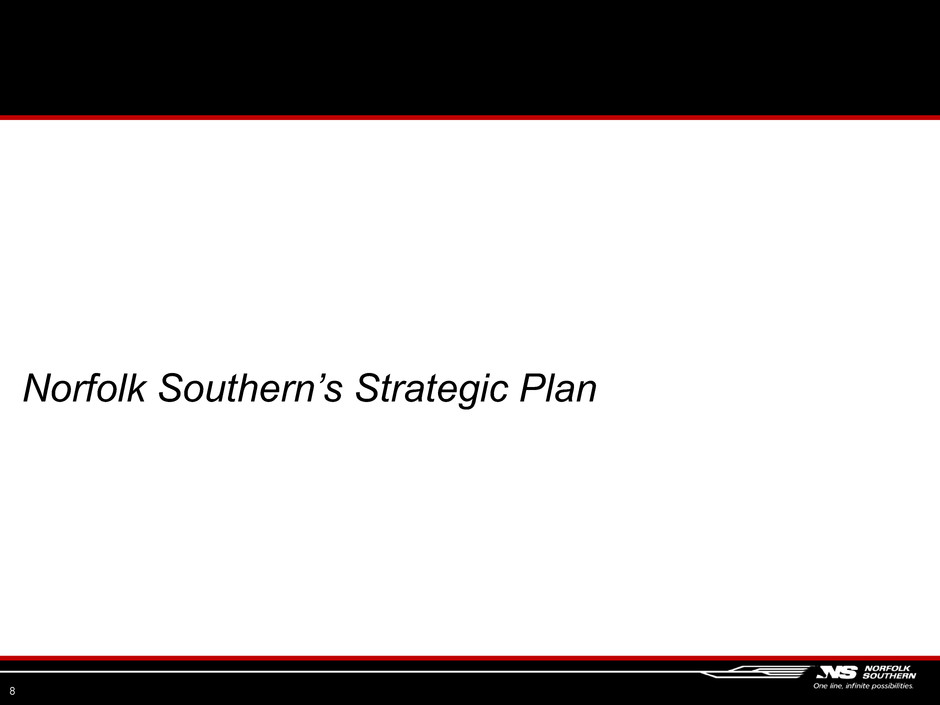
8 Norfolk Southern’s Strategic Plan
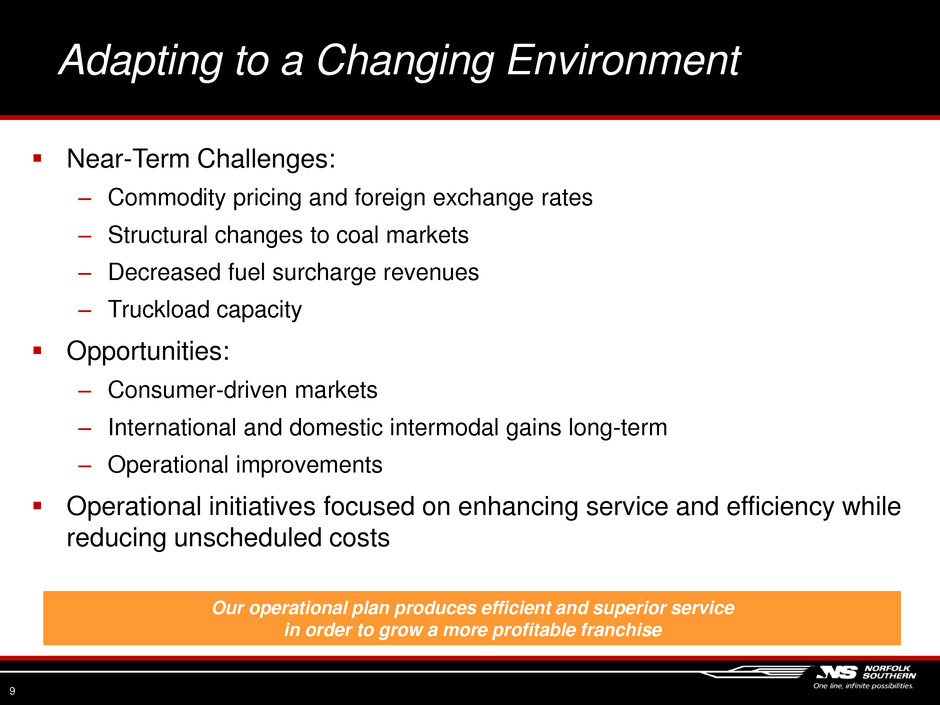
Near-Term Challenges: ‒ Commodity pricing and foreign exchange rates ‒ Structural changes to coal markets ‒ Decreased fuel surcharge revenues ‒ Truckload capacity Opportunities: ‒ Consumer-driven markets ‒ International and domestic intermodal gains long-term ‒ Operational improvements Operational initiatives focused on enhancing service and efficiency while reducing unscheduled costs Adapting to a Changing Environment 9 Our operational plan produces efficient and superior service in order to grow a more profitable franchise
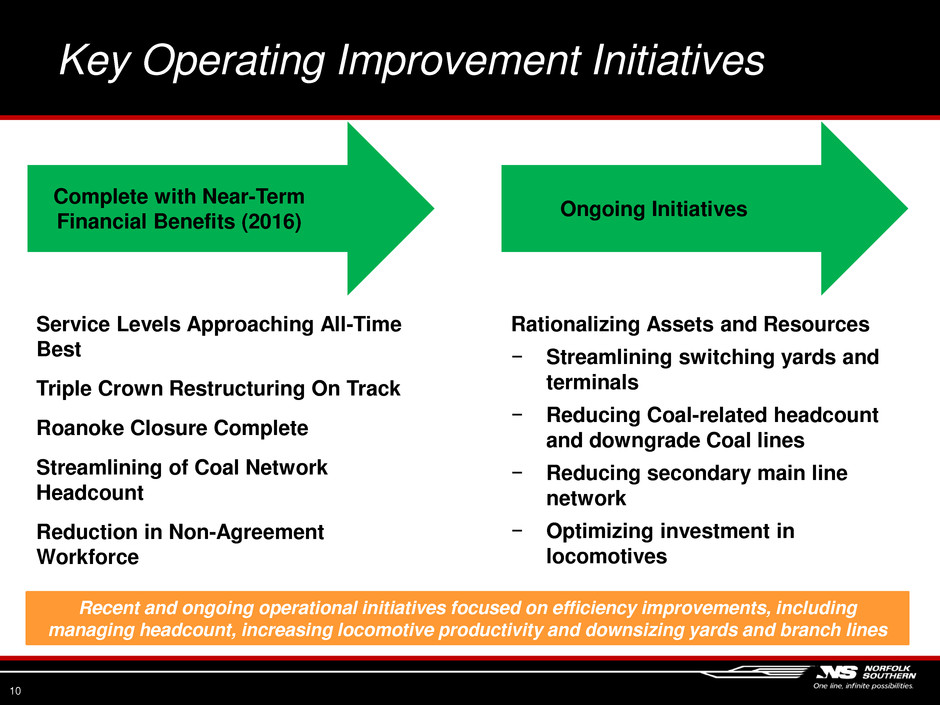
Service Levels Approaching All-Time Best Triple Crown Restructuring On Track Roanoke Closure Complete Streamlining of Coal Network Headcount Reduction in Non-Agreement Workforce Key Operating Improvement Initiatives 10 Rationalizing Assets and Resources − Streamlining switching yards and terminals − Reducing Coal-related headcount and downgrade Coal lines − Reducing secondary main line network − Optimizing investment in locomotives Complete with Near-Term Financial Benefits (2016) Ongoing Initiatives Recent and ongoing operational initiatives focused on efficiency improvements, including managing headcount, increasing locomotive productivity and downsizing yards and branch lines

11 * Most Current Data Available Positive Operational Momentum A faster railroad is a less expensive and more profitable railroad 50% 55% 60% 65% 70% 75% 80% 85% 90% Ja n Fe b M ar A p r M ay Ju n Ju l A u g Se p O ct N o v D ec Composite Service Performance (1) Current: 82% Train Speed (2) Better ( ) Current: 25.0 mph Better ( ) Current: 21.8 hrs Terminal Dwell (2) 16 18 20 22 24 26 Ja n Fe b M ar A p r M ay Ju n Ju l A u g Se p O ct N o v D ec 15 20 25 30 35 40 45 Ja n Fe b M ar A p r M ay Ju n Ju l A u g Se p O ct N o v D ec 2015 2014 2013 Notes: (1) Composed of train performance (40%), plan adherence (30%) and connection performance (30%) (2) 7-day rolling average *
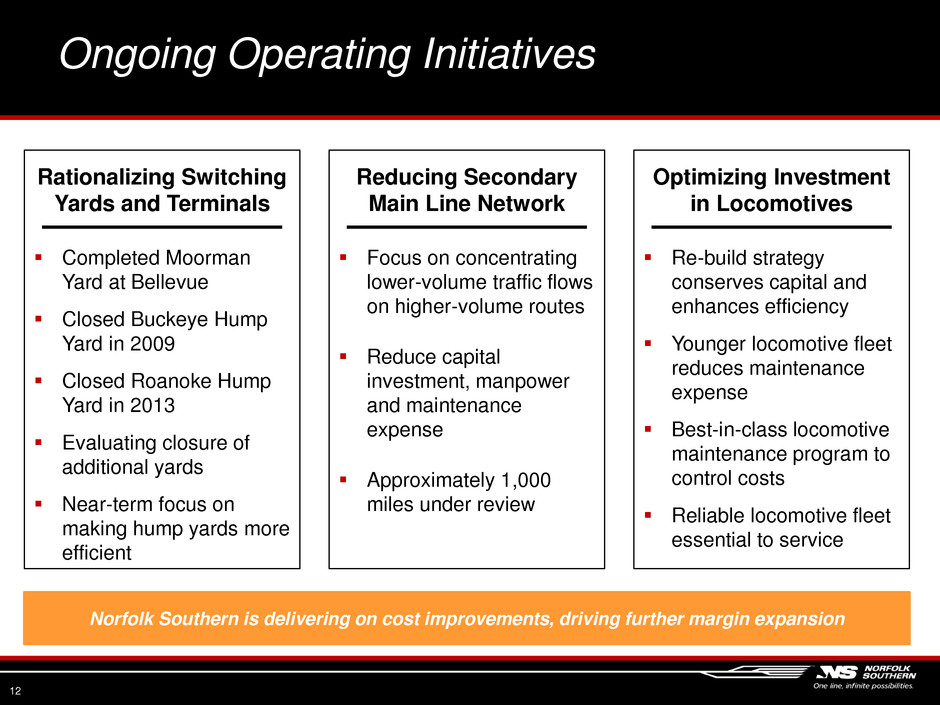
Ongoing Operating Initiatives Rationalizing Switching Yards and Terminals 12 Completed Moorman Yard at Bellevue Closed Buckeye Hump Yard in 2009 Closed Roanoke Hump Yard in 2013 Evaluating closure of additional yards Near-term focus on making hump yards more efficient Reducing Secondary Main Line Network Focus on concentrating lower-volume traffic flows on higher-volume routes Reduce capital investment, manpower and maintenance expense Approximately 1,000 miles under review Optimizing Investment in Locomotives Re-build strategy conserves capital and enhances efficiency Younger locomotive fleet reduces maintenance expense Best-in-class locomotive maintenance program to control costs Reliable locomotive fleet essential to service Norfolk Southern is delivering on cost improvements, driving further margin expansion
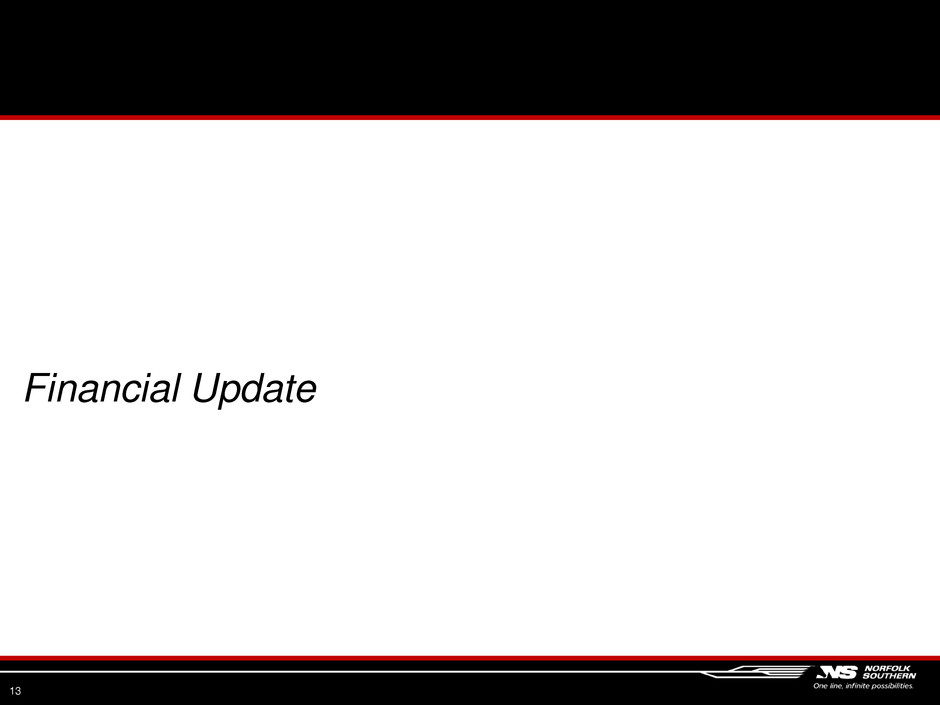
13 Financial Update

Improved Pricing Volume Growth Reduction in Capital Spending Operating Improvement Initiatives Operating Ratio Below 65 Pursue Disciplined Capital Allocation Strategy While Investing Appropriately in the Network Foundations of Strategic Plan 14 Realizable strategy to drive long-term value creation for shareholders
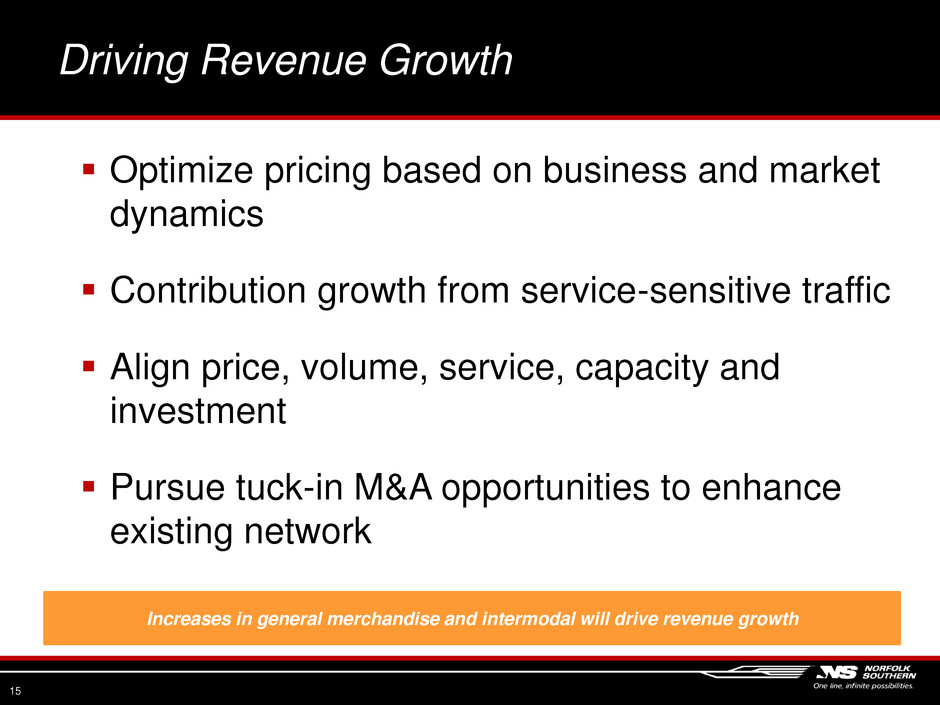
Optimize pricing based on business and market dynamics Contribution growth from service-sensitive traffic Align price, volume, service, capacity and investment Pursue tuck-in M&A opportunities to enhance existing network Driving Revenue Growth 15 Increases in general merchandise and intermodal will drive revenue growth
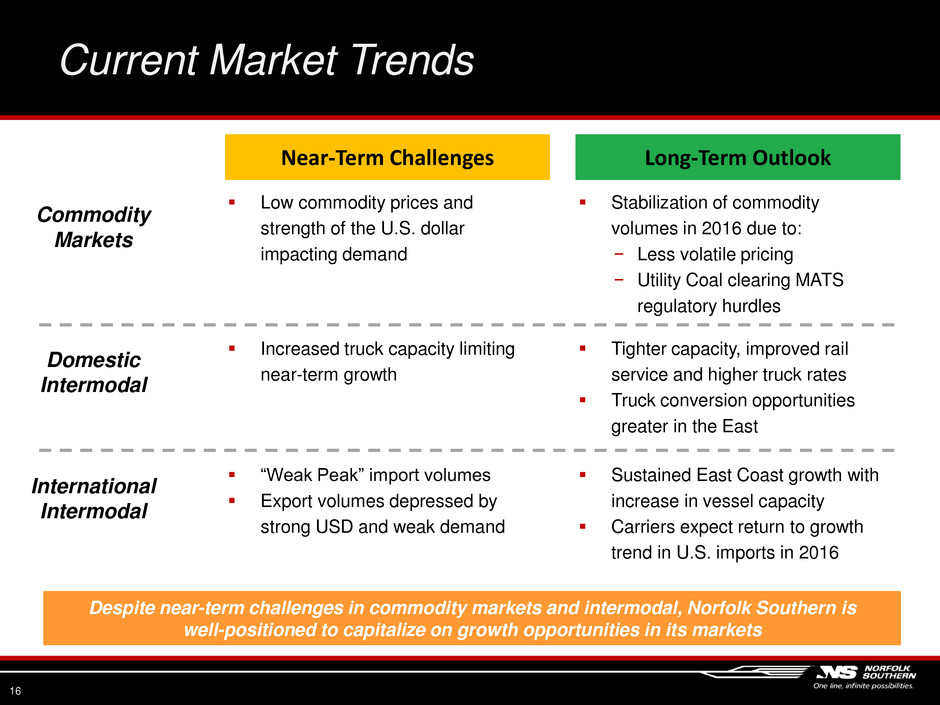
16 Current Market Trends Near-Term Challenges Long-Term Outlook Commodity Markets Domestic Intermodal International Intermodal Low commodity prices and strength of the U.S. dollar impacting demand Stabilization of commodity volumes in 2016 due to: − Less volatile pricing − Utility Coal clearing MATS regulatory hurdles Increased truck capacity limiting near-term growth Tighter capacity, improved rail service and higher truck rates Truck conversion opportunities greater in the East “Weak Peak” import volumes Export volumes depressed by strong USD and weak demand Sustained East Coast growth with increase in vessel capacity Carriers expect return to growth trend in U.S. imports in 2016 Despite near-term challenges in commodity markets and intermodal, Norfolk Southern is well-positioned to capitalize on growth opportunities in its markets
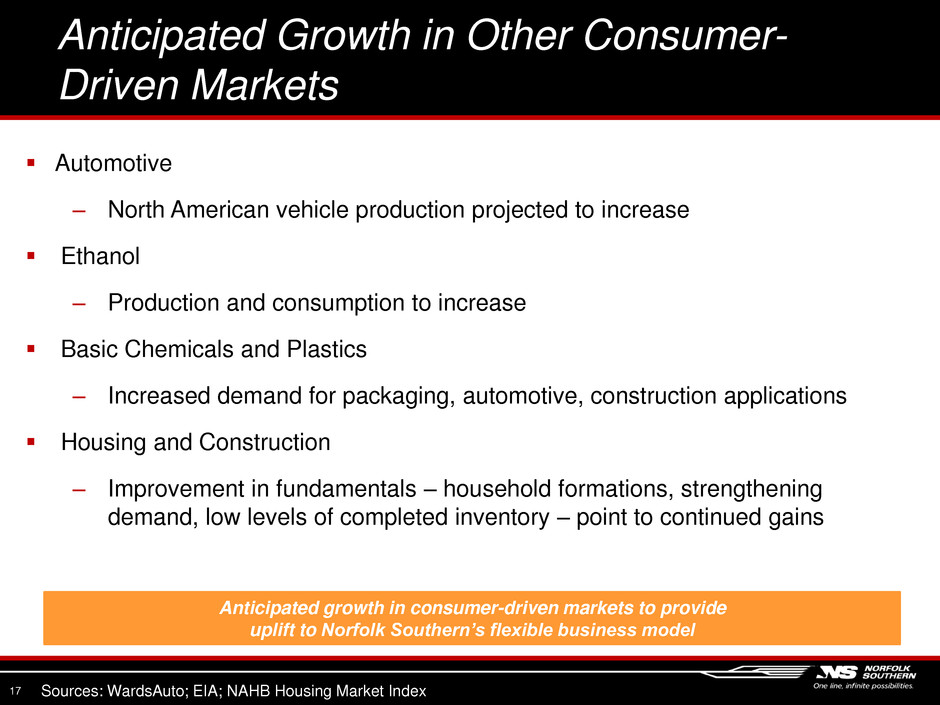
Anticipated Growth in Other Consumer- Driven Markets 17 Sources: WardsAuto; EIA; NAHB Housing Market Index Automotive ‒ North American vehicle production projected to increase Ethanol ‒ Production and consumption to increase Basic Chemicals and Plastics ‒ Increased demand for packaging, automotive, construction applications Housing and Construction ‒ Improvement in fundamentals – household formations, strengthening demand, low levels of completed inventory – point to continued gains Anticipated growth in consumer-driven markets to provide uplift to Norfolk Southern’s flexible business model
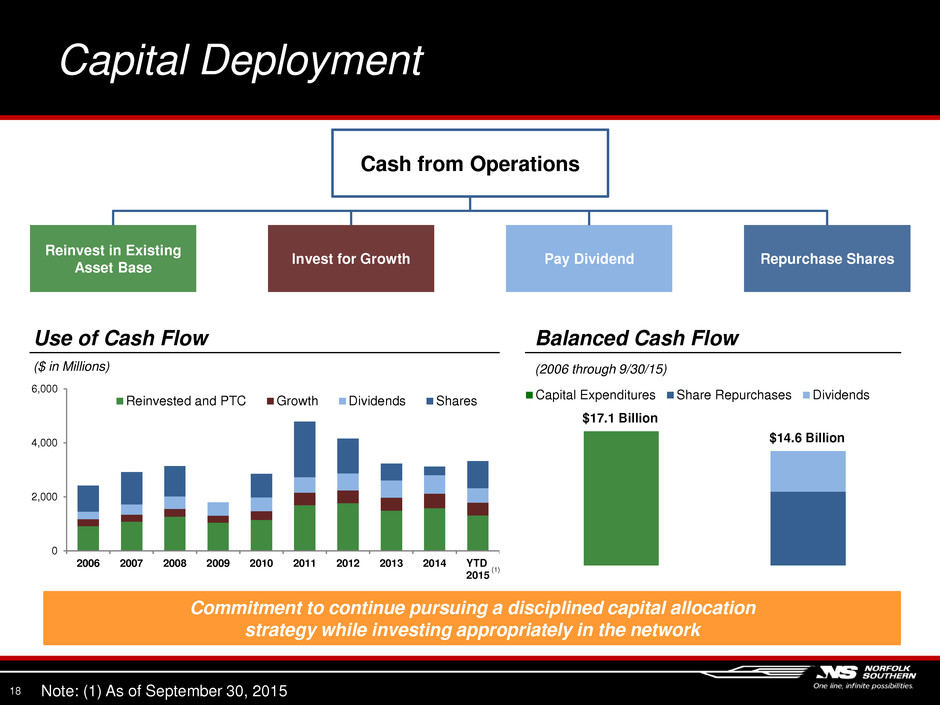
Capital Deployment 18 0 2,000 4,000 6,000 2006 2007 2008 2009 2010 2011 2012 2013 2014 YTD 2015 Reinvested and PTC Growth Dividends Shares Capital Expenditures Share Repurchases Dividends Balanced Cash Flow (2006 through 9/30/15) Use of Cash Flow ($ in Millions) $17.1 Billion $14.6 Billion Commitment to continue pursuing a disciplined capital allocation strategy while investing appropriately in the network Cash from Operations Reinvest in Existing Asset Base Invest for Growth Pay Dividend Repurchase Shares Note: (1) As of September 30, 2015 (1)
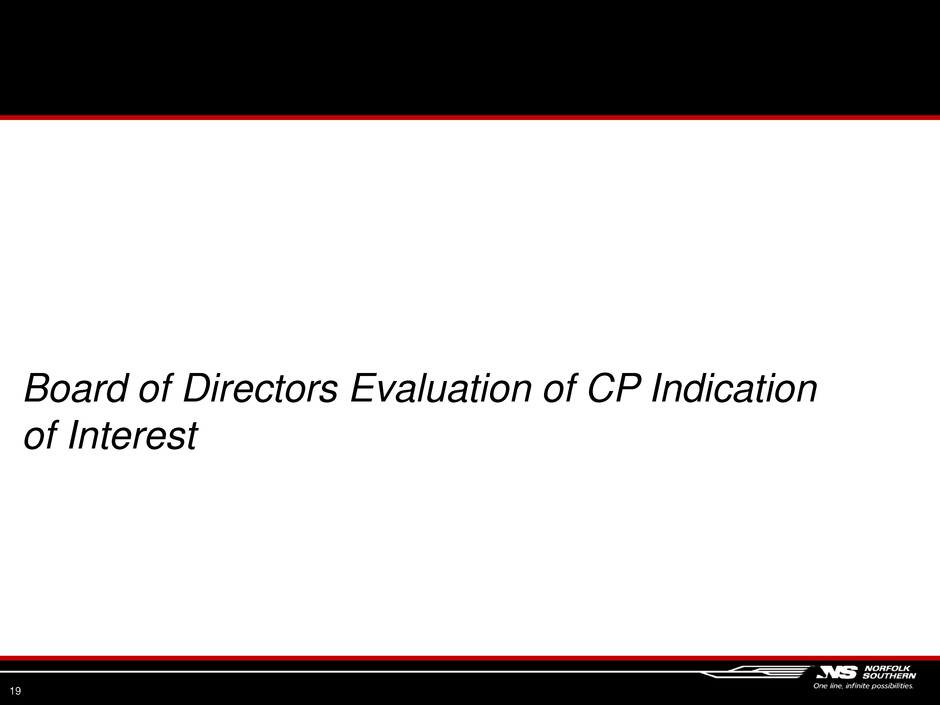
19 Board of Directors Evaluation of CP Indication of Interest
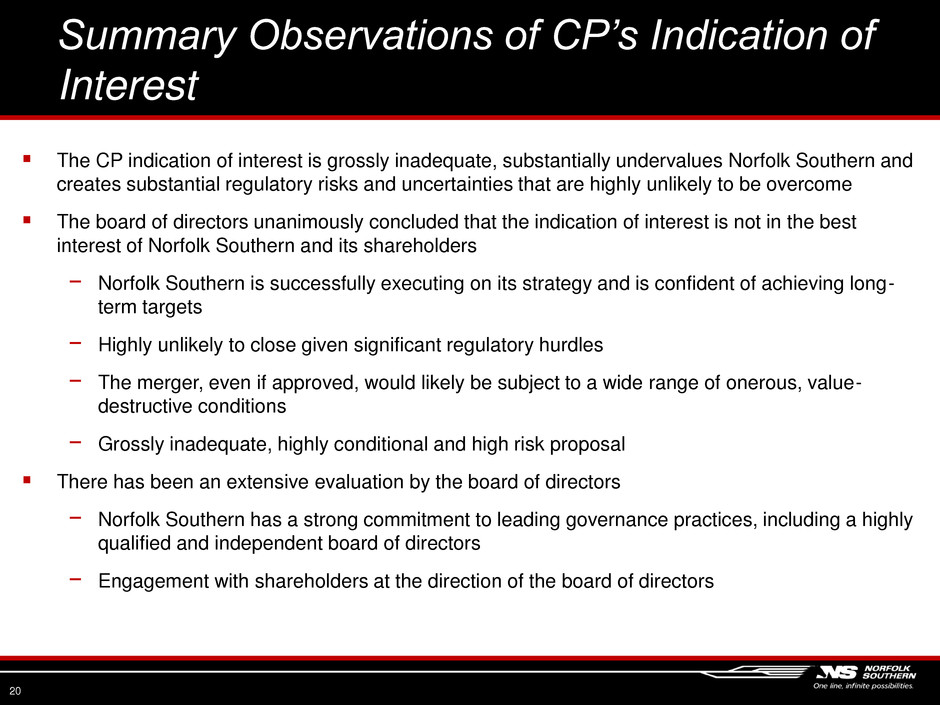
Summary Observations of CP’s Indication of Interest 20 The CP indication of interest is grossly inadequate, substantially undervalues Norfolk Southern and creates substantial regulatory risks and uncertainties that are highly unlikely to be overcome The board of directors unanimously concluded that the indication of interest is not in the best interest of Norfolk Southern and its shareholders − Norfolk Southern is successfully executing on its strategy and is confident of achieving long- term targets − Highly unlikely to close given significant regulatory hurdles − The merger, even if approved, would likely be subject to a wide range of onerous, value- destructive conditions − Grossly inadequate, highly conditional and high risk proposal There has been an extensive evaluation by the board of directors − Norfolk Southern has a strong commitment to leading governance practices, including a highly qualified and independent board of directors − Engagement with shareholders at the direction of the board of directors
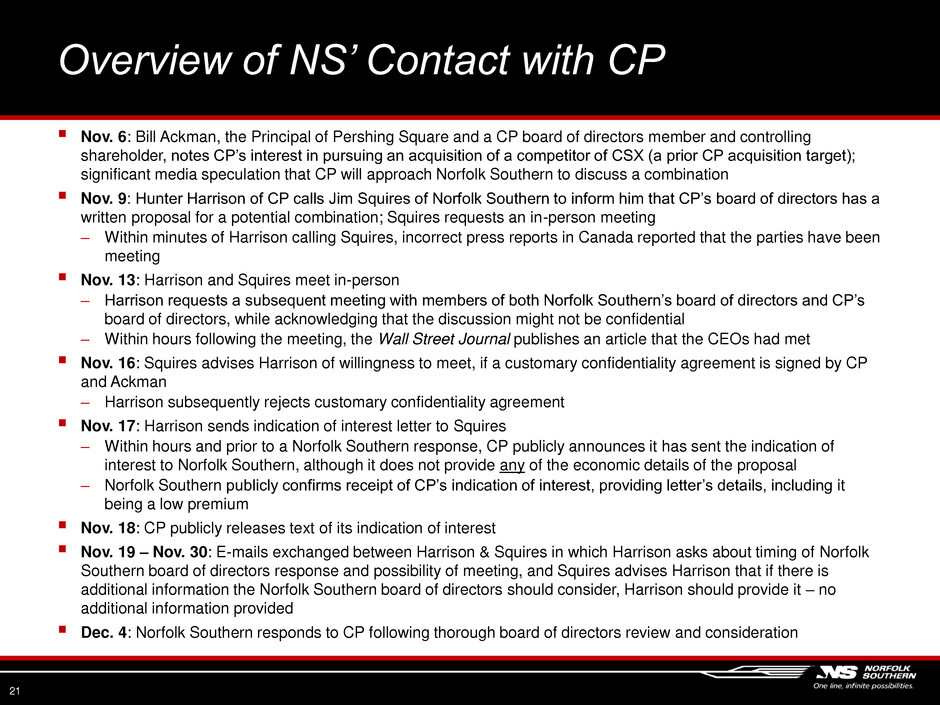
Nov. 6: Bill Ackman, the Principal of Pershing Square and a CP board of directors member and controlling shareholder, notes CP’s interest in pursuing an acquisition of a competitor of CSX (a prior CP acquisition target); significant media speculation that CP will approach Norfolk Southern to discuss a combination Nov. 9: Hunter Harrison of CP calls Jim Squires of Norfolk Southern to inform him that CP’s board of directors has a written proposal for a potential combination; Squires requests an in-person meeting – Within minutes of Harrison calling Squires, incorrect press reports in Canada reported that the parties have been meeting Nov. 13: Harrison and Squires meet in-person – Harrison requests a subsequent meeting with members of both Norfolk Southern’s board of directors and CP’s board of directors, while acknowledging that the discussion might not be confidential – Within hours following the meeting, the Wall Street Journal publishes an article that the CEOs had met Nov. 16: Squires advises Harrison of willingness to meet, if a customary confidentiality agreement is signed by CP and Ackman – Harrison subsequently rejects customary confidentiality agreement Nov. 17: Harrison sends indication of interest letter to Squires – Within hours and prior to a Norfolk Southern response, CP publicly announces it has sent the indication of interest to Norfolk Southern, although it does not provide any of the economic details of the proposal – Norfolk Southern publicly confirms receipt of CP’s indication of interest, providing letter’s details, including it being a low premium Nov. 18: CP publicly releases text of its indication of interest Nov. 19 – Nov. 30: E-mails exchanged between Harrison & Squires in which Harrison asks about timing of Norfolk Southern board of directors response and possibility of meeting, and Squires advises Harrison that if there is additional information the Norfolk Southern board of directors should consider, Harrison should provide it – no additional information provided Dec. 4: Norfolk Southern responds to CP following thorough board of directors review and consideration Overview of NS’ Contact with CP 21
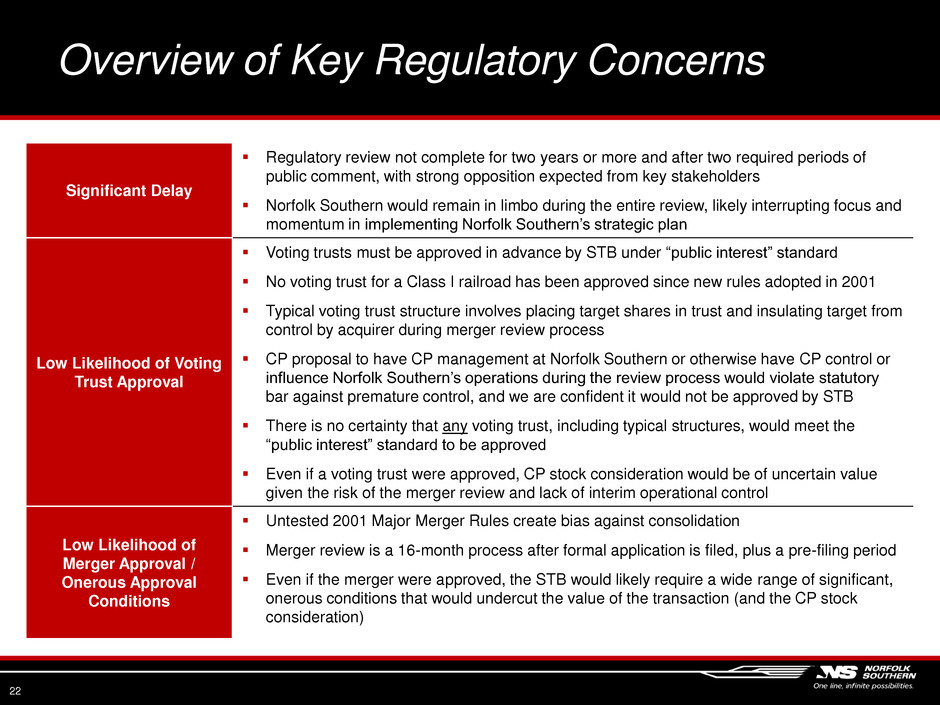
Overview of Key Regulatory Concerns 22 Significant Delay Regulatory review not complete for two years or more and after two required periods of public comment, with strong opposition expected from key stakeholders Norfolk Southern would remain in limbo during the entire review, likely interrupting focus and momentum in implementing Norfolk Southern’s strategic plan Low Likelihood of Voting Trust Approval Voting trusts must be approved in advance by STB under “public interest” standard No voting trust for a Class I railroad has been approved since new rules adopted in 2001 Typical voting trust structure involves placing target shares in trust and insulating target from control by acquirer during merger review process CP proposal to have CP management at Norfolk Southern or otherwise have CP control or influence Norfolk Southern’s operations during the review process would violate statutory bar against premature control, and we are confident it would not be approved by STB There is no certainty that any voting trust, including typical structures, would meet the “public interest” standard to be approved Even if a voting trust were approved, CP stock consideration would be of uncertain value given the risk of the merger review and lack of interim operational control Low Likelihood of Merger Approval / Onerous Approval Conditions Untested 2001 Major Merger Rules create bias against consolidation Merger review is a 16-month process after formal application is filed, plus a pre-filing period Even if the merger were approved, the STB would likely require a wide range of significant, onerous conditions that would undercut the value of the transaction (and the CP stock consideration)
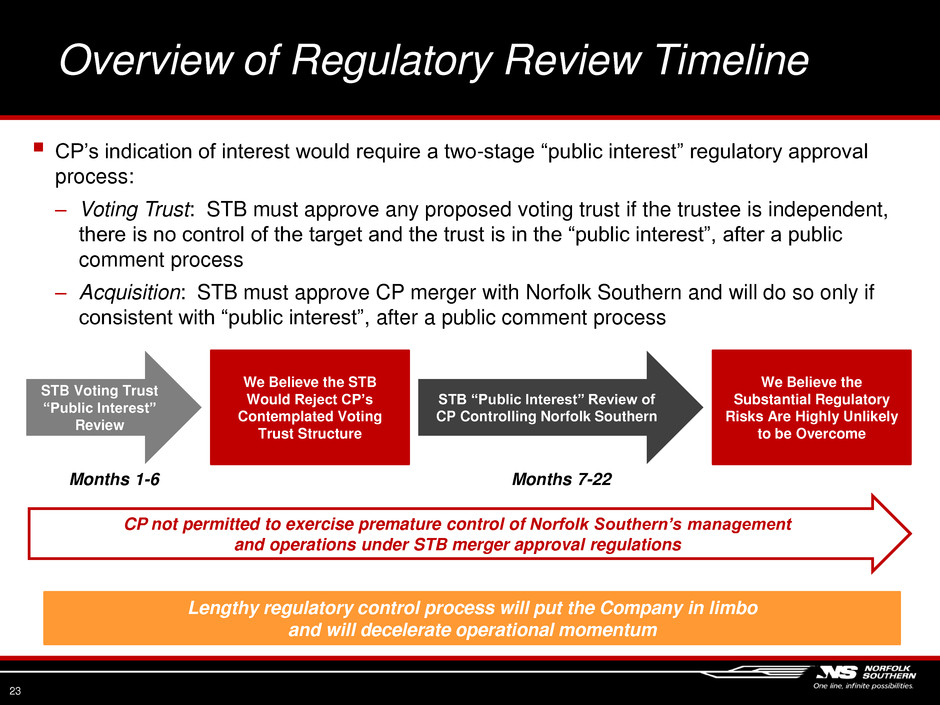
CP’s indication of interest would require a two-stage “public interest” regulatory approval process: – Voting Trust: STB must approve any proposed voting trust if the trustee is independent, there is no control of the target and the trust is in the “public interest”, after a public comment process – Acquisition: STB must approve CP merger with Norfolk Southern and will do so only if consistent with “public interest”, after a public comment process Overview of Regulatory Review Timeline 23 STB Voting Trust “Public Interest” Review We Believe the STB Would Reject CP’s Contemplated Voting Trust Structure STB “Public Interest” Review of CP Controlling Norfolk Southern We Believe the Substantial Regulatory Risks Are Highly Unlikely to be Overcome Months 1-6 Months 7-22 CP not permitted to exercise premature control of Norfolk Southern’s management and operations under STB merger approval regulations Lengthy regulatory control process will put the Company in limbo and will decelerate operational momentum
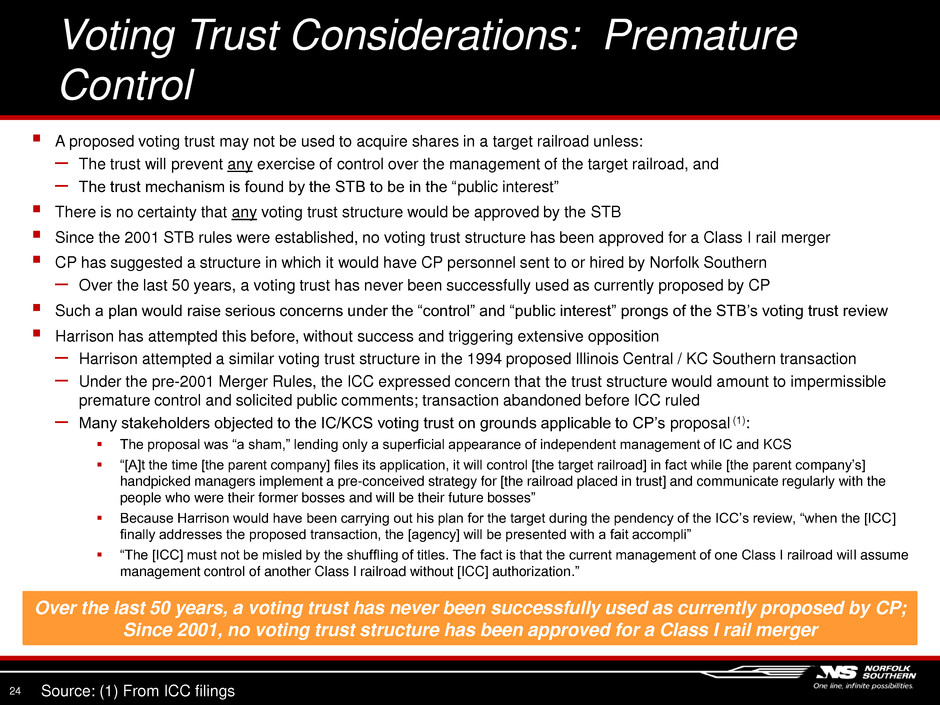
Voting Trust Considerations: Premature Control 24 A proposed voting trust may not be used to acquire shares in a target railroad unless: – The trust will prevent any exercise of control over the management of the target railroad, and – The trust mechanism is found by the STB to be in the “public interest” There is no certainty that any voting trust structure would be approved by the STB Since the 2001 STB rules were established, no voting trust structure has been approved for a Class I rail merger CP has suggested a structure in which it would have CP personnel sent to or hired by Norfolk Southern – Over the last 50 years, a voting trust has never been successfully used as currently proposed by CP Such a plan would raise serious concerns under the “control” and “public interest” prongs of the STB’s voting trust review Harrison has attempted this before, without success and triggering extensive opposition – Harrison attempted a similar voting trust structure in the 1994 proposed Illinois Central / KC Southern transaction – Under the pre-2001 Merger Rules, the ICC expressed concern that the trust structure would amount to impermissible premature control and solicited public comments; transaction abandoned before ICC ruled – Many stakeholders objected to the IC/KCS voting trust on grounds applicable to CP’s proposal (1): The proposal was “a sham,” lending only a superficial appearance of independent management of IC and KCS “[A]t the time [the parent company] files its application, it will control [the target railroad] in fact while [the parent company’s] handpicked managers implement a pre-conceived strategy for [the railroad placed in trust] and communicate regularly with the people who were their former bosses and will be their future bosses” Because Harrison would have been carrying out his plan for the target during the pendency of the ICC’s review, “when the [ICC] finally addresses the proposed transaction, the [agency] will be presented with a fait accompli” “The [ICC] must not be misled by the shuffling of titles. The fact is that the current management of one Class I railroad will assume management control of another Class I railroad without [ICC] authorization.” Over the last 50 years, a voting trust has never been successfully used as currently proposed by CP; Since 2001, no voting trust structure has been approved for a Class I rail merger Source: (1) From ICC filings
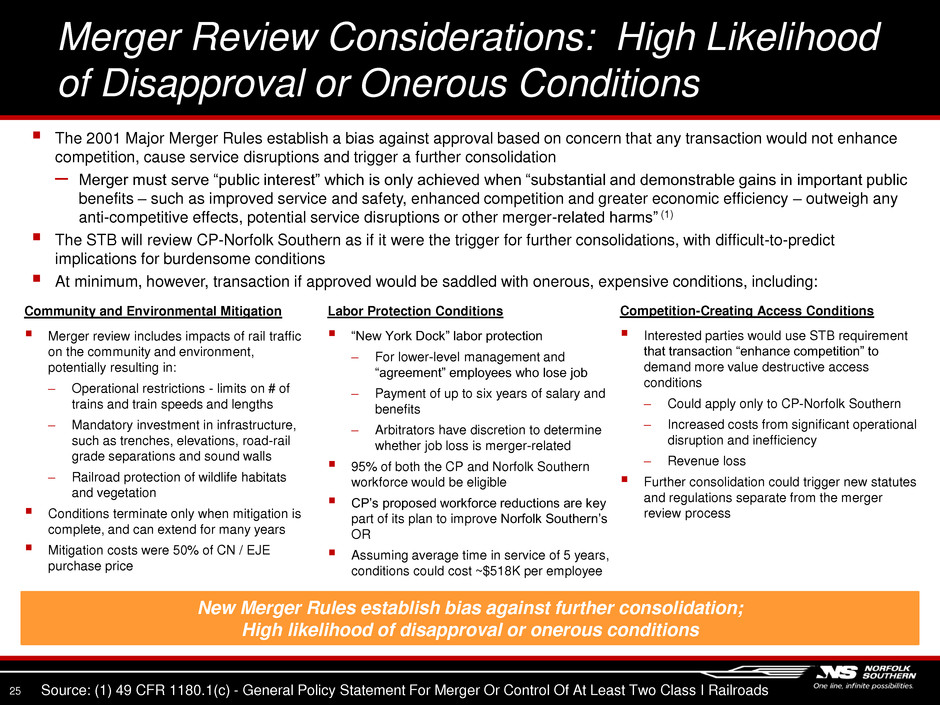
Competition-Creating Access Conditions Interested parties would use STB requirement that transaction “enhance competition” to demand more value destructive access conditions – Could apply only to CP-Norfolk Southern – Increased costs from significant operational disruption and inefficiency – Revenue loss Further consolidation could trigger new statutes and regulations separate from the merger review process Labor Protection Conditions “New York Dock” labor protection – For lower-level management and “agreement” employees who lose job – Payment of up to six years of salary and benefits – Arbitrators have discretion to determine whether job loss is merger-related 95% of both the CP and Norfolk Southern workforce would be eligible CP’s proposed workforce reductions are key part of its plan to improve Norfolk Southern’s OR Assuming average time in service of 5 years, conditions could cost ~$518K per employee Community and Environmental Mitigation Merger review includes impacts of rail traffic on the community and environment, potentially resulting in: – Operational restrictions - limits on # of trains and train speeds and lengths – Mandatory investment in infrastructure, such as trenches, elevations, road-rail grade separations and sound walls – Railroad protection of wildlife habitats and vegetation Conditions terminate only when mitigation is complete, and can extend for many years Mitigation costs were 50% of CN / EJE purchase price Merger Review Considerations: High Likelihood of Disapproval or Onerous Conditions 25 The 2001 Major Merger Rules establish a bias against approval based on concern that any transaction would not enhance competition, cause service disruptions and trigger a further consolidation – Merger must serve “public interest” which is only achieved when “substantial and demonstrable gains in important public benefits – such as improved service and safety, enhanced competition and greater economic efficiency – outweigh any anti-competitive effects, potential service disruptions or other merger-related harms” (1) The STB will review CP-Norfolk Southern as if it were the trigger for further consolidations, with difficult-to-predict implications for burdensome conditions At minimum, however, transaction if approved would be saddled with onerous, expensive conditions, including: New Merger Rules establish bias against further consolidation; High likelihood of disapproval or onerous conditions Source: (1) 49 CFR 1180.1(c) - General Policy Statement For Merger Or Control Of At Least Two Class I Railroads
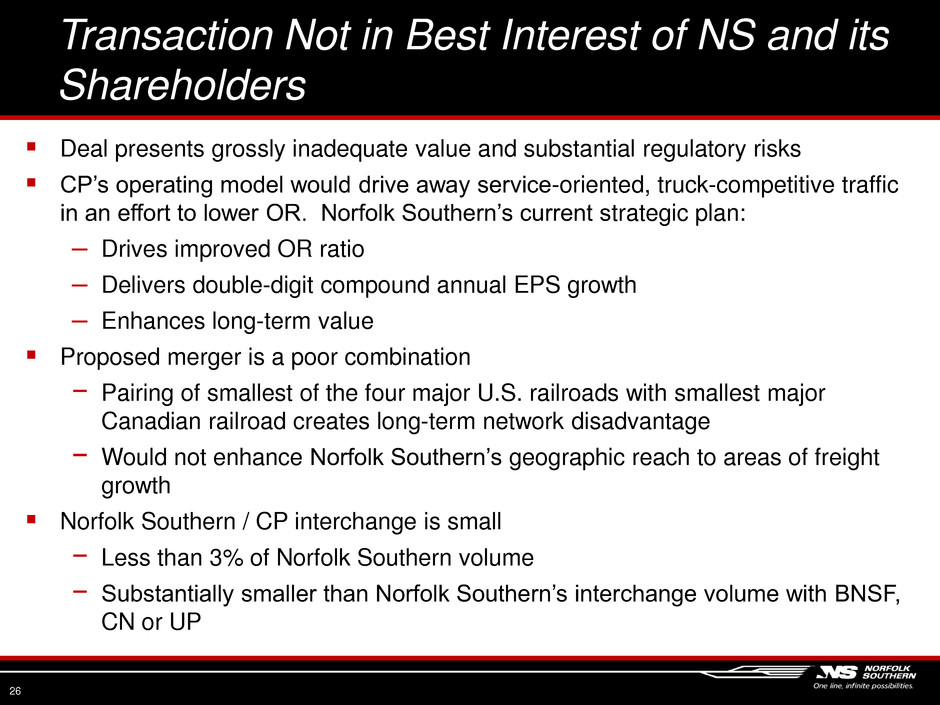
Transaction Not in Best Interest of NS and its Shareholders 26 Deal presents grossly inadequate value and substantial regulatory risks CP’s operating model would drive away service-oriented, truck-competitive traffic in an effort to lower OR. Norfolk Southern’s current strategic plan: – Drives improved OR ratio – Delivers double-digit compound annual EPS growth – Enhances long-term value Proposed merger is a poor combination − Pairing of smallest of the four major U.S. railroads with smallest major Canadian railroad creates long-term network disadvantage − Would not enhance Norfolk Southern’s geographic reach to areas of freight growth Norfolk Southern / CP interchange is small − Less than 3% of Norfolk Southern volume − Substantially smaller than Norfolk Southern’s interchange volume with BNSF, CN or UP
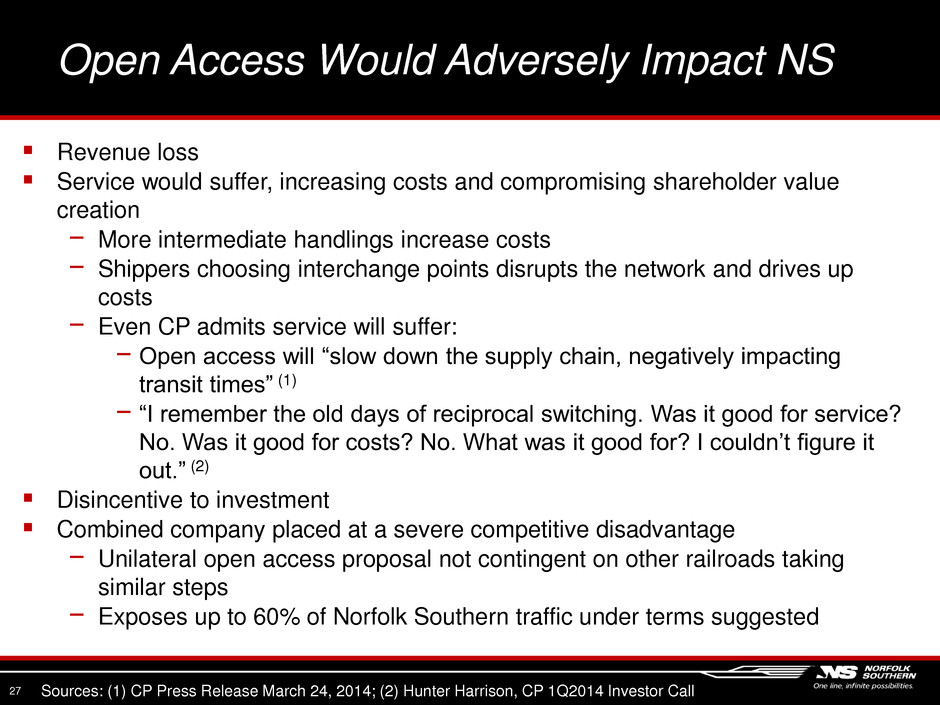
Revenue loss Service would suffer, increasing costs and compromising shareholder value creation − More intermediate handlings increase costs − Shippers choosing interchange points disrupts the network and drives up costs − Even CP admits service will suffer: − Open access will “slow down the supply chain, negatively impacting transit times” (1) − “I remember the old days of reciprocal switching. Was it good for service? No. Was it good for costs? No. What was it good for? I couldn’t figure it out.” (2) Disincentive to investment Combined company placed at a severe competitive disadvantage − Unilateral open access proposal not contingent on other railroads taking similar steps − Exposes up to 60% of Norfolk Southern traffic under terms suggested Open Access Would Adversely Impact NS 27 Sources: (1) CP Press Release March 24, 2014; (2) Hunter Harrison, CP 1Q2014 Investor Call
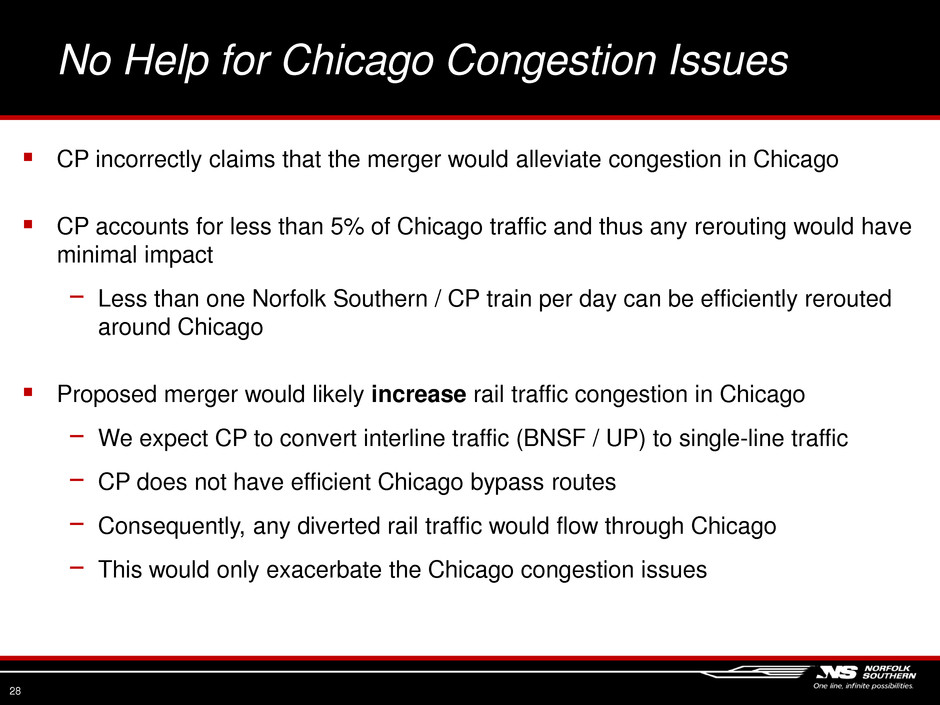
No Help for Chicago Congestion Issues 28 CP incorrectly claims that the merger would alleviate congestion in Chicago CP accounts for less than 5% of Chicago traffic and thus any rerouting would have minimal impact − Less than one Norfolk Southern / CP train per day can be efficiently rerouted around Chicago Proposed merger would likely increase rail traffic congestion in Chicago − We expect CP to convert interline traffic (BNSF / UP) to single-line traffic − CP does not have efficient Chicago bypass routes − Consequently, any diverted rail traffic would flow through Chicago − This would only exacerbate the Chicago congestion issues
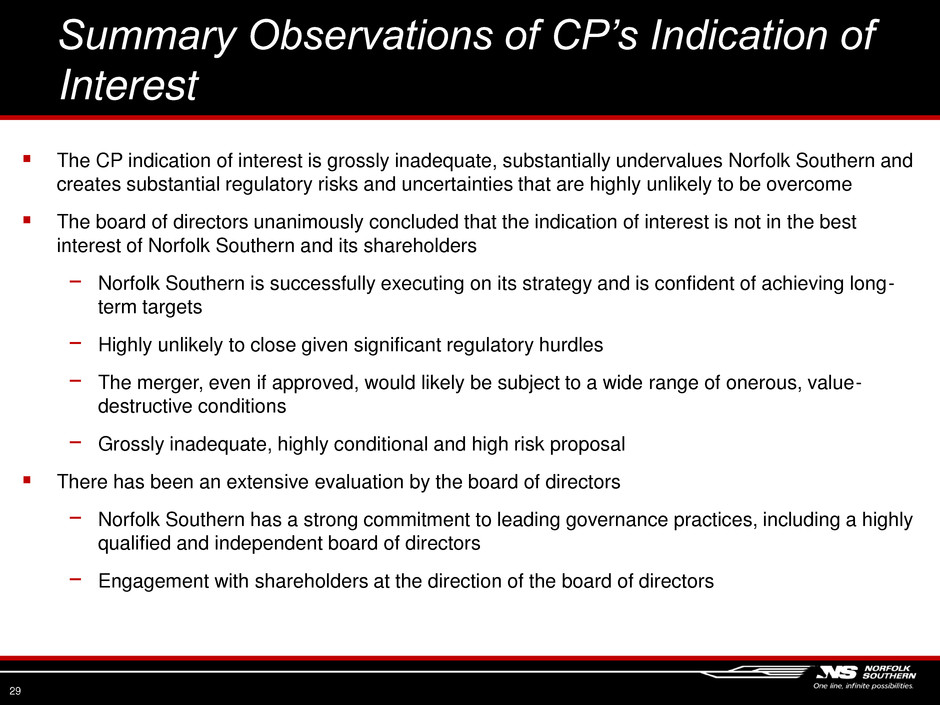
Summary Observations of CP’s Indication of Interest 29 The CP indication of interest is grossly inadequate, substantially undervalues Norfolk Southern and creates substantial regulatory risks and uncertainties that are highly unlikely to be overcome The board of directors unanimously concluded that the indication of interest is not in the best interest of Norfolk Southern and its shareholders − Norfolk Southern is successfully executing on its strategy and is confident of achieving long- term targets − Highly unlikely to close given significant regulatory hurdles − The merger, even if approved, would likely be subject to a wide range of onerous, value- destructive conditions − Grossly inadequate, highly conditional and high risk proposal There has been an extensive evaluation by the board of directors − Norfolk Southern has a strong commitment to leading governance practices, including a highly qualified and independent board of directors − Engagement with shareholders at the direction of the board of directors




























